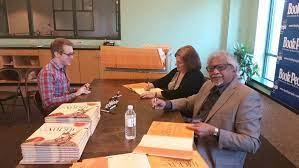This book tells the story of Arun Gandhi’s experiences growing up as the grandson of Mahatma Gandhi, the renowned leader of the Indian independence movement and an advocate of non-violence.
In the book. Arun Gandhi shares his memories of living with his grandfather at the Sevagram ashram in India. He describes the profound lessons he learned from Gandhiji, including the principles of non-violence, love, and truth. The story also explores the challenges young Arun faced as he struggled to understand and embody these principles in his daily life.
Grandfather Gandhi offers young readers a glimpse into the life and teachings of Mahatma Gandhi through the eyes of his grandson.
My Gandhi Story by Nina Sabnani and Ankit Chadha with illustrations by Rajesh Chaitya Vangad
This picture book is a great choice for reading aloud to children. It’s a collaborative effort involving a Warli artist, a storyteller, and an animation film-maker. The book features beautiful traditional Warli paintings by the artist Rajesh Chaitya Vangad, illustrating Gandhiji’s life.
The story is presented through short snippets and questions from a childlike narrator, with Gandhiji providing the answers. For example, when asked if he worked hard in school, Gandhi replied that he was not lazy but found multiplication difficult and was shy.
Three voices tell this story: the narrator, the curious child, and Gandhiji himself. Together, they introduce children to the political leader making him relatable to young readers.
Great Lives: Mohandas Karamchand Gandhi by Aditi De and illustrated by Pooja Pottenkulam
This book has a unique style, combining descriptive text with a format similar to graphic novels or comics books, which easily captivates children. Every few pages, the story switches to a comic book format, complementing the text. The first chapter describes Gandhiji’s birth and family, while the comics depict scenes from his childhood, such as his vow to care for his parents inspired by a tale from the Ramayana. It also portrays his first encounter with the injustices of untouchability and the caste system when his mother prohibited him from sharing sweets and playing with his friend Uka, who belonged to an oppressed caste.
When asked why today’s children should read about the leader even more than 150 years after his birth, the author, Aditi De, explains, “Children today have few icons to look up to. barring sports or screen stars. Once high school students realise that young Mohandas had dilemmas and fears like theirs, they identify with him powerfully. During my workshops on this book, whether at Bangalore or Ambala, young readers have often chosen Gandhian tools to resolve our polarised world’s problems. That filled me with wonder.”
Mahatma Gandhi: The Father of the Nation by Subhadra Sen Gupta
Written by an accomplished author who has received the Sahitya Akademi Bal Sahitya Award, this biography of Mahatma Gandhi is an engaging book for readers of all ages. It invites readers to imagine what Gandhiji’s era was like evoking laughter, deep contemplation. and wonder SUBHADRA SE PTA
Throughout the book, Gandhiji’s principles on various topics, such as equality, secularism, humour, kindness, simplicity, non-violence, self-reliance, education, and empowerment, are presented in an engaging manner.
The author even delves into the Mahatma’s dietary habits, noting, “His meals were so plain that people avoided sitting next to him because he would offer them his plain boiled vegetables without salt, oil, or spices, along with bitter neem chutney, which he claimed aided digestion.” Despite his simple lifestyle, Gandhiji’s popularity was immense, as “people would travel for days and then patiently wait under the scorching sun for hours just for a chance to catch a glimpse of him.”
The Mahatma and the Monkeys edited by Anu Kumar
This book brings together the most Captivating moments that shaped Gandhiji’s life and highlights his most significant sayings. It explores his relentless pursuit of truth, equality, and freedom. drawing valuable lessons and powerful words from his remarkable journey. Gandhiji never gave excuses like, “What can I do, I’m only one person.” Instead, he asserted. “In a gentle way, you can shake the world.” He proved this to be true. That’s why, even years after his passing, his actions and words hold great significance in our world today.
At the end of each chapter, you will find a collection of thought-provoking quotes from Gandhiji, and there’s also a fun quiz for young readers towards the end of the book.
Picture Credit: Google





